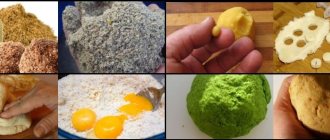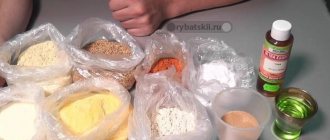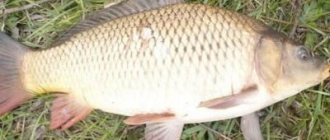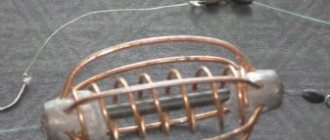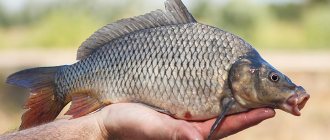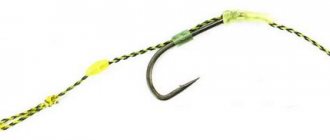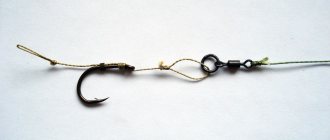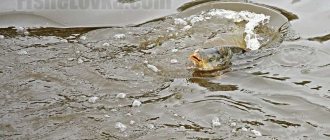Ingredients
If we are talking about self-prepared complementary foods, then you should remember that it must contain large fractions of the product.
Since bream is a large fish, reaching over 1 kilogram of weight, complementary feeding should be appropriate. The list of ingredients is quite long, but the preferences of the fish should be taken into account.
What can you use:
- peas in any form;
- porridge from pearl barley, millet, oatmeal, wheat;
- dry oat flakes;
- breadcrumbs;
- corn flour;
- cake and bran;
- peanut;
- roasted sunflower seeds;
- cornflakes;
- bloodworms, maggots, dung worms;
- canned corn and peas;
A considerable list of products can be added to this list; this depends on the fisherman’s imagination.
How to make dough for carp
The simplest and most popular recipe is using mashed bread.
To do this you need:
- take a small amount of bread;
- dip it in water;
- swing slowly in your hand;
It is advisable to use water from the reservoir where fishing will take place. We must not forget about strict adherence to a specific consistency. The mixture should remain sticky so as not to fall off the hook, and at the same time not stick too much to the fisherman's hands. If there is a need to make the nozzle thicker, take some flour with you.
If you knead a relatively round piece of dough from wheat flour and add something sweet (vanilla, caramel or honey), you will be pleasantly surprised by the effectiveness of the bait. Then you need to shape the dough into balls and boil in boiling water until the balls float to the surface. At the final stage, it is necessary to cool the balls and grease them with vegetable oil.
Dough for carp fishing is often prepared in the classic way. To do this, take a glass of ground oatmeal with good solubility, pour boiling water over it and add various wet ingredients to the mixture in equal quantities.
To improve the effectiveness of the test, it is recommended to use flavoring or food coloring.
Popular recipes
From corn. Corn dough is considered a particularly effective attachment. It's quite simple to prepare. You need to boil 500 ml. water, and then add a little flour and oatmeal. To achieve good stickiness and thickness, the mixture is supplemented with gelatin. If you are making this recipe, you should lower the heat while you're at it, and then add sugar (usually 2 tablespoons) to the pan. When bubbles form, you must periodically add the dry mixture to the pan. This must be done until the bait has completely hardened. The finished product is placed in a refrigerated place.
Recipe "Delight"
The container is placed on low heat, and then a teaspoon of honey, 250 ml, is poured into it. water, 1.5 tsp. vanilla and 4 tsp. Sahara. After boiling, add a small amount of corn flour and stir thoroughly for 4 minutes until a homogeneous mass is formed.
At the final stage, the prepared product must be removed from liquid using a board or other object that can be used as a press.
Other options
- Mix a small amount of potatoes, two boiled yolks and fresh bread, preferably made from premium or first grade flour. After that, sugar and salt are added to the mixture and it is kneaded until a thick, homogeneous consistency is formed. The workpiece is placed on low heat and cooked for 30 minutes.
- Roasted barley is ground in a coffee grinder. Then add a few tablespoons of flour and boiled potatoes. The mixture is thoroughly stirred and boiled. The finished dumpling can be supplemented with caramel or honey syrup.
- The following dough recipe involves using cottage cheese, water and honey. The ingredients are placed in a saucepan, mixed and simmered over low heat until a sticky consistency forms.
- The dough made from the pulp of a loaf with honey in a ratio of 10 to 1 also has good results. The loaf should be well saturated with honey and acquire the desired aroma.
The above recipes for creating dough for carp are far from the limit of your fishing imagination.
When preparing bait, it is important to maintain a certain consistency, but do not be afraid to experiment. In this case, you can make a fishing dough that will surprise you with its effectiveness.
Explore different ingredients and don't be afraid to experiment. In this case, you are guaranteed a good bite.
Carp dough made from corn flour
Boil one pint of water in a saucepan
Mix 2 cups instant oats with one cup plain flour in a bowl. Add half a sachet of gelatin to boiling water
Reduce gas, add 2 tablespoons of sugar and one tablespoon of vanilla sugar..
Cover the surface of the water with the dry mixture. Bubbles will begin to break out. Cover them again with the mixture. Repeat this operation until all the dry mixture is gone.
Fishing for peaceful fish using dough is quite popular almost all over the world. However, such a bait is rarely used on carp. Most anglers prefer to fish with corn, peas, pellets, boilies and other options. Although in some reservoirs carp bite much better and more willingly on the dough. Therefore, let’s look at how best to use this attachment in carp fishing.
For carp fishing, sometimes the most effective bait is dough
Dough as a bait for carp fishing
In fact, dough is one of the simplest and most accessible baits for carp. Every angler can prepare it. You just need to know what ingredients to use and how to mix it correctly.
However, first I would like to talk in more detail about the test as a carp bait. Let’s say right away that there is no doubt about its effectiveness. Properly prepared dough attracts carp no worse (and maybe better) than expensive boilies and pellets. Then why do many carp fishermen ignore catching carp with this bait?
It is easy to “prepare” by providing “over-the-top help” to your wife when she prepares salads for the household that contain canned corn. For the dough, take corn flour and breadcrumbs in a ratio of 1 to 1 and mix.
Bring the corn juice (its ratio to flour and breadcrumbs is approximately 2/3) to a boil in a small saucepan. Add flour and crackers to the boiling liquid, remembering to stir.
Steaming the dough is done in the same way as it was done with pea dough. As our “brew” cools, mix everything thoroughly to the desired consistency with the addition of flour.
It is very convenient to knead the “steamed” dough on newspaper, since excess moisture is absorbed by the paper, speeding up the entire process of preparing the dough.
To conclude the topic of our conversation, let me repeat myself and say that your desire, patience and a little imagination will allow you to create a bait from dough to suit the taste of any picky fish, without incurring large material costs and supernatural efforts.
Search, experiment and don’t forget to share your achievements with other fishermen!
© Yuri Le (2013)
Seed dough - a recipe for one of the best attachments
Dough for crucian carp and crucian carp is one of the best recipes for making dough from flour, semolina, potatoes with the addition of butter.
Recipes for popular plant baits - ten of the best recipes for preparing baits for catching almost any peaceful fish.
Millet for bait is a popular method of cooking millet for adding to bait.
Groundbait corn is an inexpensive and effective bait additive. Recipe for cooking corn and method of mixing with base bait.
How to prepare peas for fishing - one of the best baits for large bream and carp
Dough as carp bait
When going to any body of water for carp, you must have dough among other baits. This universal catch bait often helps out during bad bites.
All anglers are familiar with the test for catching peaceful fish. Many people in early childhood used this attachment to fish for bleak, roach, silver bream and crucian carp on a light fishing rod with a goose feather float. It was made according to a simple recipe - a handful of flour, water, a teaspoon of sunflower oil and a pinch of sugar.
This approach will not work in carp fishing. You need to take the preparation of the bait seriously. Dough recipes are distinguished by the presence of additional components to give the bait the properties necessary for successful hunting for these large fish.
Advantages
The dough is a universal bait that is definitely worth trying during summer carp fishing. Its main advantages:
- made from natural products;
- all ingredients are available in all grocery stores;
- a huge number of diverse recipes;
- is well absorbed by fish, almost without saturating it;
- is conveniently absorbed by carp without causing suspicion, thanks to its soft consistency;
- cuts off small fish, especially ruffs, gobies and perches.
With the help of various aromatic additives, the angler can give the bait the necessary smell, which will attract fish from a long distance to the fishing zone. And food coloring will increase the contrast of the bait on any bottom structure.
Flaws
The carp test also has its disadvantages that cannot be ignored:
- The bait is not liked by those who do not like to cook on their own, but are accustomed to fishing with purchased boilies and bulk bait mixtures.
- If prepared incorrectly, it does not hold well on the hook, it can fly off when the equipment hits the water, and it is easily knocked down by fish when biting.
- High demands on freshness. Carp ignores sour bait, which, on the contrary, will scare it away from the fishing zone.
We recommend reading: Catchable wobblers for trout fishing
A catchy dough doesn’t just need to be prepared correctly. You need to be able to put it on a hook and store it so that it does not spoil prematurely.
Flavors
To make the bait have a more pronounced smell, various flavorings are added to it. They are usually purchased at the store, and they are not too expensive. When using them, you must follow the instructions.
If attractants are added in small quantities, then the fish will not smell them, but if you add too much, you can completely scare away both bream and other individuals. The correct ratio of complementary foods with flavoring increases the catch efficiency by 80%.
Both artificial and natural flavors are added. Among natural ones, the following are often used:
- Anise and hemp.
- Cinnamon, cumin, coriander.
- Dill.
- Garlic juice.
How to bait dough for carp fishing. Technique
When fishing for carp with dough, special attention should be paid to placing it on the hook , since if the bait is incorrectly attached, the bait can fly off the hook, causing a lot of inconvenience. The following tricks are most often used for this:
In this case, a spring removed from an ordinary disposable lighter is put on the shank of the hook. This allows the bait to stay on the hook much tighter. When using small hooks, the spring should be shortened.
Hook with spring.- Adding cotton wool . Fluffed cotton wool fibers are added to the finished bait. They are a kind of reinforcement that connects the particles of the nozzle. Care must be taken to ensure that no inhomogeneities or lumps are formed.
- Using beads on hair accessories . A plastic bead is attached to the hair, onto which the bait is stuck. The bead holds the dough even during sharp long-distance casts. You can also use a foam ball instead - especially if fishing conditions (for example, muddy bottom) require a floating bait.
When fishing in reservoirs with a current, it is necessary to re-throw the tackle more often , as it will erode the dough faster. In order to reduce unwanted bites from small fish, balls formed from bait for catching carp and carp should not be made too small.
Dough recipe - “Jelly”
• Mix in a saucepan over low heat a teaspoon of honey, 1 glass of water, one and a half teaspoons of vanilla and 4 teaspoons of sugar. As soon as our mixture deigns to boil, carefully pour in 1 cup of corn flour and quickly stir the mixture for about 3 minutes until the mixture becomes a homogeneous mass.
Next, place the dough on a board and press it down with another board, leave for 2 minutes. Then the dough should be turned over and left again for 2 minutes, and then put into a storage bag.
• Take 2 cups of plain flour, 2 cups of instant oatmeal, 2 cups of water. Mix everything in a saucepan and stir until it forms a dough.
Next, add 1 tablespoon of vanilla, 4 tablespoons of syrup and sprinkle the dough with cinnamon. Cook the dough further and stir until a thick mass forms.
The readiness of the dough is checked as follows: You need to tear off a small piece of dough from the overall piece. Roll out a ball from it and throw it on the floor - if the ball of dough does not jump 5 or 10 cm, then the dough needs to be cooked some more.
• All the recipes that I have listed in this article are just a small fraction of all the recipes for carp dough. There are a huge number of dough components: sweeteners, flavorings, crushed grains. The list of such components is endless, so experiment.
Mix together 1 cup of water, one and a half teaspoons of vanilla, one teaspoon of honey and 4 teaspoons of sugar in a saucepan over low heat. When the mixture comes to a boil, carefully stir in one cup of cornmeal.
Give the mixture a quick stir and stir for 3 minutes until it forms a smooth dough. Place it on a cutting board.
Press the dough down with another board and let sit for 1-2 minutes, then turn over and let sit for another 2 minutes. After this, pack it in a storage bag.
- 2 cups of flour
- 2 cups instant oats (Quaker)
- 2 glasses of water
Place everything in pans and stir to form a dough. Add 1 tablespoon vanilla, 4 tablespoons syrup, sprinkle with cinnamon. Cook further and stir until you get a dense mass again. To check for doneness, tear off a piece of dough, make a ball and throw it on the floor. If it doesn’t jump 5-10 cm, it means you need to cook it some more.
All of the above recipes do not even cover the very tip of the giant iceberg of all kinds of test recipes for carp fishing.
There are a huge number of ingredients, such as crushed grains, sweeteners, branded flavors.
Everything from rice flour and various types of rye, wheat, corn flour. The list is endless.
All the recipes in this article can give you something to experiment with. By replacing water with eggs, we get boilies, which are essentially “hard balls of dough.”
And here's what you need to know: Carp reels and rods. Carp rigs || Shimano reel for carp fishing
Preparing thick dough for fishing
The recipe is quite simple, just add a raw egg to the regular dough. In this case, it rolls perfectly into balls and does not stick to your fingers, which is very convenient. Such dough is not only nutritious for fish, but it is pleasant to work with.
Hard to Knead Dough Recipe
So that the dough does not dissolve in water so quickly and stays on the hook for a long time, pieces of cotton wool are added to it. The cotton wool allows the balls to be held securely on the hook. The main thing is not to overdo it with cotton wool, otherwise you will get the opposite effect.
Dough with seeds
Sunflower seeds, if passed through a meat grinder or blended, improve the aroma of the dough. This has a positive effect on the bite, making it more active. In this case, you need to observe the proportions and monitor the thickness and viscosity of the dough. If there are a lot of seeds, the balls are unlikely to stay on the hook.
Dough with sunflower oil
Sunflower oil can be used as a flavoring. It can successfully replace seeds. The main thing is that the oil is not refined. The most aromatic oil can be bought at the market where private entrepreneurs trade. Since oil does not dissolve in water, the dough can stay on the hook for a long time.
Dough with anise butter
The aroma of anise is quite effective at attracting fish. To prepare such a dough, add a few drops of anise oil to the already prepared dough. In any case, you should not add a lot of oil so that the fish may not be wary of the overly strong aroma.
Dough with garlic added
Oddly enough, the smell of garlic can attract some types of peaceful fish. At the same time, dough with the aroma of garlic can awaken the fish’s appetite and activate the bite. To get such a dough, just add garlic juice to a regular dough and mix.
Dough with potatoes
Fish such as carp and crucian carp will always be interested in boiled potatoes. As a rule, it is added to the already prepared dough and kneaded well to obtain a homogeneous consistency. If you use dough with potatoes, you can count on catching large specimens of crucian carp, carp or other fish.
Dough with semolina
Almost all peaceful fish respond with pleasure to baits that contain semolina. You should add ¼ of the semolina to the dough, and by adding water, the dough of the desired thickness is kneaded. Many fishermen prepare the dough with semolina alone, and it works flawlessly.
Dough with semolina and boiled potatoes
First you need to combine dry ingredients, such as flour and semolina. Then water is added to the dry mixture and the dough is kneaded, after which boiled potatoes are added to it. It is very important to add the right amount of potatoes so that the balls roll perfectly.
How to extract gluten from dough
Almost everyone knows that the quality of flour depends on the percentage of gluten in it. Paradoxically, it is precisely this that is interesting for fish.
However, not everyone knows that gluten needs to be extracted without much effort. To do this, you need to take the dough and place it in a container or bag that allows water to pass through.
The bag should be placed under the water tap and, as it were, washed off the looser surface. At the same time, you need to constantly squeeze it out.
After the loose components leave, gluten will remain in the bag, similar to chewing gum and colorless in color. By using gluten as a nozzle, you can get an almost unbreakable nozzle.
Moreover, this is what interests the fish.
To make it clear how to do this, you can watch the video. Thanks to this viewing, you can learn how to prepare the most catchy baits for fishing.
As bait for bream, you can use mixtures that are sold in fishing stores specifically for this purpose. To do this, you need to collect water from the reservoir where fishing takes place and pour it into the dry mixture for bait.
The amount of liquid must be adjusted so that the resulting mixture easily forms into balls. To increase the effectiveness of bites, it would be useful to add a little bait and mix.
The presence of bait in the bait leads to the fact that the fish, after trying several pieces, loses its vigilance. As a result, it is quite possible that next time the hook will be swallowed. Bream is one of the smartest and most cautious river fish; it quickly learns to recognize the tricks of fishermen. Therefore, in order to outsmart him you have to resort to tricks.
Balls with bait can be thrown into the fishing point by hand, using a slingshot, a radio-controlled boat, or swimming in a boat. You shouldn’t overdo it, because the school of fish will quickly get enough and a bite won’t happen.
You should take into account the fact that carp has an excellent sense of smell. Therefore, the feed mixture must be made fragrant and suitable for consumption.
- Makukha – sunflower seeds pressed into husks. Characteristic of southern Russia and Ukraine.
- Semolina porridge with sunflower seeds (roasted) – boil 100 grams of semolina in water. From what you have cooked, you now need to prepare the dough. To do this, you need to mix boiled semolina with dry, while gradually adding seeds, ground to a powder (50 grams). This mixture is long-lasting and carp loves it incredibly.
- Clay and porridge (possibly adding white bread) – mix clay with wheat or corn porridge, you can add peas or bread. Roll this into balls.
- Boilies - mix several balls with a diameter of 1 centimeter with clay and water. The beauty of the balls is that they can be treated with flavored substances that carp love so much. He gives preference to fruity scents. Flavorings can be purchased in specialized stores.
Start fishing early in the morning. This is the most favorable time of day. Fishing for carp can bring good results at any time of the year, except winter.
With a skillful choice of gear, there is a high probability of catching an individual weighing 10 kg or more.
If you want to return home with a good catch, you must arrive at the place 2 days before fishing. At this time, you can simply rest and feed the fish so that it gets used to one point. With this method, the chance of catching a trophy carp increases significantly.
- In the early hours before dawn, the carp comes out to feed. This continues until 10-11 o'clock. You can't miss this time. Focus on the characteristic splashes of water.
- When you find a carp hole, mark its boundaries. The carp pecks when exiting or entering the pit.
- Provide complementary feeding in several places. In this case, there is a high probability of attracting fish. Use only one place for fishing.
Recipe one
The easiest way to prepare such a nozzle is to moisten the bread crumb with water from a reservoir. This version of the test is often used on impromptu, spontaneous fishing trips.
Second recipe
Regular wheat flour is mixed with water, and a little syrup from raspberry or strawberry jam is added to the resulting mixture - it colors the nozzle pinkish, and also gives additional smell and taste. This combination is often to the taste of carp.
Third option
The same wheat flour is kneaded in water, a little cinnamon, salt and sugar are added to the resulting dough. As additional flavorings, you can use chopped dill, ginger, garlic juice, cocoa, and honey. Bream often like this dough.
Fourth option
This cooking method is somewhat more complicated. In this case, the dough is kneaded with milk (wheat flour is used) with the addition of honey and egg yolk.
And here's what you need to know: Delhi fishing nets
After all the ingredients have been added, the resulting dough is rolled into small balls, which then need to be boiled for a few minutes. To prevent the finished balls from sticking together, they are lubricated with a small amount of sunflower oil.
The finished bait is very reminiscent of boilies, and is liked by most representatives of the carp family.
Fifth method
Peas must be ground to flour, then mixed with the same finely ground oatmeal. The same volume of water as the mixture is brought to a boil, after which the mixture itself is poured into water and steamed over low heat until the water evaporates.
The resulting mass may be liquid; the desired consistency is given to it by adding wheat flour. This dough works well when catching large carp.
Pea flour is mixed with oatmeal crushed in a coffee grinder in a ratio of 1 to 2. Salt and sugar are added.
Take an amount of water equal to the volume of the mixture and bring it to a boil. The prepared mixture is poured into boiling water and steamed over low heat, while steaming occurs with constant stirring to prevent burning.
This steaming usually occurs for approximately 5-7 minutes, until all the water has evaporated.
Then the container with the steamed mixture is closed with a lid, wrapped in a towel and left to “sweat” for 10-15 minutes. During this time, our mixture (the consistency will be a little liquid) cools down to a temperature that allows you to knead it with your hands.
We give the necessary elasticity to the dough by kneading and adding the required amount of semolina or wheat flour to it. The amount of final additions is determined by the consistency of the dough.
Without exaggeration, such pea dough can be called an indispensable bait for catching trophy carp.
Dough made from plain flour, better than wheat, has long been used for pastry. Of the numerous and varied recipes, we present only a few, so to speak, basic ones.
- Mix flour with raw egg white and add honey.
- A stiff dough is prepared, to which it is a good idea to add an egg or honey, as well as a little powdered sugar and vegetable oil, which should also be used to grease the prepared kolob. It is good to make the required size katashi from the prepared dough and scald them with boiling water. This gives the bait an attractive scent and somewhat increases its stability on the hook.
- Dumplings are made and boiled in sunflower oil until tender.
- Steep dough is made with fruit and berry juice, preferably strawberry.
- Dissolve a spoonful of sugar and a pinch of vanillin in a quarter cup of water, knead the wheat dough and grind with unrefined sunflower oil until a homogeneous mass is obtained.
It is convenient to store the dough in a toothpaste tube. The back of the tube is opened, the inside is thoroughly washed (with potassium permanganate too), the tube is filled with dough and rolled up again.
Now you just need to unscrew the cap, press lightly, and the resulting “sausage” can be wrapped around the hook. Dough made from wheat flour is sometimes tinted red with food coloring, which gives positive results when fishing.
Sweet dough
The sprouted barley is first dried, then lightly fried in the oven, then thoroughly crushed in a coffee grinder, mixed with a small amount of flour, finally mashed boiled potatoes are added and everything is kneaded well.
A dumpling is formed from the resulting dough, boiled until tender, removed from the water and kneaded again, adding a little honey or syrup, as well as a few drops of anise oil or crushed anise (fennel).
This dough is made no later than the day before fishing. This bait is designed for carp.
Dough with garlic and other flavors
- Take 100 g of white bread crumb and two peeled boiled potatoes of medium size, pass through a meat grinder several times, add three cloves of finely grated garlic, a few drops of vegetable oil and mix everything. This dough is an excellent bait for catching bream and roach.
- A small amount of flour is mixed with water until a homogeneous mass is obtained. Then add a little oil (sunflower, corn) or beat in the egg yolk and mix again. To add flavor, dry or liquid flavoring is added to the dough.
Typically, flavored dough is widely used as the basis for boilies - special baits for catching carp, trout and other fish. The simplest and most common flavoring is garlic. One or two cloves, grated, are enough for the dough to acquire a unique aroma. Anise and dill drops and menthol oil are often used.
Dough with egg yolk
Fresh white crumb, two boiled yolks, boiled potatoes are kneaded in a small amount of water until a homogeneous soft dough is obtained, into which you can drop a little vegetable oil.
French dough
Coarse flour is poured into cold boiled milk with constant stirring. The resulting thick dough-like mass is placed in a frying pan and kneaded over low heat until sufficient density is achieved. Then a hard-boiled crushed yolk, a little boiled potato are added to the mass and everything is mixed.
Curd dough
The crumbly cottage cheese is ground with a spoonful of honey in a small amount of water, slowly brought to a boil, adding enough wheat flour during cooking to make a viscous dough. This attachment is especially effective when fishing for carp and bream.
But tench is not indifferent to other bait. It uses sour cottage cheese that has stood in a warm place, which is kneaded with the pulp of white bread.
Plates of this dough can be placed on a brick, put into the oven, and removed when they turn slightly yellow and smell pleasant. .
Pea dough
Another recipe is using peas. You need to take 100 grams of pre-cooked peas and grind them until smooth.
Next, the resulting mass is mixed with also boiled rolled oats flakes in a ratio of 1/2, flour is added, after which the dough is kneaded. A regular pancake is molded from the dough and fried in a frying pan in sunflower oil.
This bait has a very strong aroma and is most attractive to carp. .
Artificial dough
In fishing stores you can also purchase a variety of ready-made dough of good quality. This dough can be used either on its own or as a mixture with bread crumbs.
If you want to make a good artificial dough at home, then the main thing is a high-quality base mixture in a 50:50 ratio. You must decide whether you want to add powdered ingredients (seasonings, colors, sweeteners) or whether they should be in liquid form.
Powdered additives include curry powder, cheese powder, or natural extracts such as crab powder, mussel powder, or flower powder. Before adding liquid, thoroughly mix all ingredients into the main mixture.
If you are making a 50:50 dough, it is good to add water or eggs. It is recommended to add eggs to both steep (hard) and soft dough for greater elasticity.
Beat the eggs thoroughly, add all the liquid ingredients, seasonings, oils or flavor enhancers, then slowly add the powder, stirring constantly. Take your time.
A large amount of powder can make the mixture initially dry. If the lump of dough is too soft to bait, let it sit for five minutes.
The dough will dry out and become denser. .
If you plan to freeze the dough, you can make it softer. The dough will harden in the freezer.
If you don't want to buy a formula base, make baits from dough and a variety of ingredients, using trout balls or canned or dry pet food. All this can be purchased in stores and supermarkets.
And here's what you need to know: Floats for match fishing - read on Catcher.fish
Ingredients such as canned pet food or canned fish have a sticky texture on their own and only need to be added to make a suitable bait. .
Chocolate (bitter) mixed with bread crumbs is the most common example of such bait. To make bait from a dry ingredient, such as ground trout, any product added to the bait must have a sticky compound to bind the powders to the water or eggs.
The simplest material for preparation is wheat gluten. Be careful not to add too much as this may result in rubbery baits that are unattractive to the fish.
Nozzles with gluten may be tight. In this case, you should add more milk with a low percentage of protein or baby formula.
This will balance the ingredients and make the bait more appetizing. .
Corn dough for carp
Let's look at another recipe. It includes quite a few ingredients. However, there is no doubt about its effectiveness. The dough prepared in this way will definitely help you in carp fishing:
- First, you will need corn flour and breadcrumbs (use the volume yourself) in equal proportions. Both ingredients are mixed in a glass container.
- To these are added milk powder (4-5 spoons), half a glass of flour and semolina, as well as ground sifted cake. All components are thoroughly mixed. We're done with the dry mixture. Let's move on to preparing what we will use to moisten the dough.
- Take 2-3 chicken eggs. We separate them into a separate container. We also add liquid flavors and attractants to them. Homemade options include juice from canned corn or hemp oil. You can also add a little milk or vegetable oil. At the end, don’t forget to mix everything.
- Pour the resulting liquid into the dry mixture prepared in advance. Then roll it out well with your hands. If the mass is not thick enough, add more flour or boiled potatoes.
It’s a good idea to add a little margarine to this corn dough. It will create a protective film. As a result, the dough will “behave” better in water, not disintegrate so quickly and not become colored.
Using bait
Large specimens, as a rule, are found at depth and it is very problematic to catch trophy bream from the shore. In this case, a feeder comes to the aid of the angler, with which you can make long casts.
Bait for catching bream on a feeder can be purchased at the store, but fishermen with experience have adapted to preparing it themselves at home. Traditional mixtures must contain large feed particles.
This is necessary so that when casting the feeder the mixture does not get carried away with the current. Usually, pearl barley, corn, peas, worms, maggots or bloodworms are added to the bait.
This is done to ensure that the bream remains in the same place. After all, in a matter of minutes he eats the dusty food and goes on in search of food. And if there is real food at the bottom, it will hold it.
Adviсe
The gear used is a carp rod, feeder or float rod. To successfully fish with dough, you need to follow a few simple recommendations:
- It is better to change the bait every time you recast, and if there are no bites, at least once every 20 minutes.
- When catching large carp using dough, you need to make fairly large spools.
- A nozzle that is too small will eat up small things.
- When fishing with a float rod, you can additionally feed with balls of dough.
- To prevent the nozzle from weathering, you need to keep it in a plastic bag.
- A “sandwich” made from dough and bloodworms or a worm works well as bait.
Using bait
Using dough for fishing is commonplace for most fishermen. There are many recipes for its preparation and use.
And this is not in vain, because correctly selected and prepared dough, in some cases, gives good results. It is often used to catch carp, crucian carp, and roach using a float rod.
It is one of the affordable and budget attachments. By adding, for example, a flavoring agent already on the pond, you can try and experiment what is best suited for catching fish.
In this article we bring to your attention a recipe for making dough from boiled potatoes.
The dough for fishing is potato, have you tried fishing using this attachment? If not, we recommend it. Many people know that boiled potatoes are a pretty good and attractive bait for catching carp and crucian carp.
Carp will not pass by and will always be tempted if they see an attractive cube on the hook. But one of its disadvantages is the high probability of falling off the hook during power casts.
In our practice, we use it when fishing near the shore with a float rod. But here potato dough can come as a replacement.
Fishing dough recipe
Next, let's look at the recipes. The ingredients for this attachment will be:
- potato
- flour
- salt, sugar
- sunflower oil
- bread
The presence of starch in the nozzle will only benefit us. Therefore, we use old potatoes to prepare the dough.
First, boil it in its skin until completely cooked. Afterwards, you should peel and mash, that is, make a puree.
Next, add the egg white and mash it directly into the prepared puree. Add a pinch of salt and the same amount of sugar.
Add a little flour to the resulting mixture and mix. The result should be a dense dough that will not stick in your hands.
Having made a ball out of it, throw it into boiled water and cook for about 20-30 minutes over low heat. Then let it cool.
When cooking, use a plastic bag, it’s more convenient.
The set of ingredients and the amount of bait are usually determined on the pond. Fishermen prepare all the components for bait at home and mix them before starting fishing. The composition and preparation of complementary food for bream depends on the weather and current.
For reservoirs with large or moderate currents, complementary foods with sufficient density are used. To do this, use heavy bait with the addition of soil fillers. For viscosity, you can use eggs, flour, bread, clay. During the current, complementary foods are given in small portions.
If you plan to fish for large fish, then there should be a lot of complementary food, since small fish always accumulate in the casting areas in search of food.
With a weak current. The food balls should erode within 30-45 seconds after casting. Heavier baits are thrown onto the fishing site in advance to keep the aquatic inhabitants in place.
One of the most effective baits that can be used to catch not only carp, but also bream and roach, is a semolina-based dough. The main ingredient should be boiled in water in a ratio of 3 tbsp. spoons of semolina per 6 tbsp. spoons of liquid. Cooking time, as a rule, does not exceed 3 minutes. In this case, the mixture must be constantly stirred to prevent burning.
The cooled semolina porridge should be thoroughly mixed with flour until the material of the required consistency is formed. To prevent the formed balls from falling apart, you can use additional components such as sunflower oil and honey.
According to experienced fishermen, an excellent catch is guaranteed when using a potato-based test. To begin with, the vegetable should be boiled and chopped using a grater, and then mixed with salt and sugar.
The next step is to add flour to the resulting mixture and mix it thoroughly until a homogeneous consistency is obtained. This dough may fall apart when trying to place the balls on the hook. To avoid this, it is recommended to add cotton fibers to the dough.
Fishing dough according to the method of preparation can be divided into three main groups:
- Raw. This dough is simply mixed with water, less often with any other liquid. Easy to prepare, and not much different from the dough used in cooking.
- Boiled. It differs significantly from raw in consistency, as it undergoes heat treatment - rolled balls are boiled in water until ready. The finished balls begin to float during the cooking process.
- Steamed in a water bath. This method is used if, instead of wheat flour, another option is used that contains less gluten (gluten) - a substance that gives the dough elasticity and elasticity. In this way, dough is most often prepared from corn or wheat flour.
Important! To prevent the boiled balls from sticking together, they can be dipped in vegetable oil.
Quick dough
Quick dough
So, to prepare fishing dough, take flour and gradually add water. Stir until the mixture becomes homogeneous and soft plasticine. You can do the opposite. First, pour water into the container. Then add flour a little at a time until the desired thickness is obtained. Knead the dough thoroughly, preferably with your hands. Knead until the dough comes off your fingers.
In the classic version, the finished dough for fishing should be dense, elastic and not stick to your hands.
At this stage, various flavors are added to the dough. As well as other “catchable” components, which will be discussed in this article below.
Many fishermen knead the dough right on the spot, on a pond, using water from it. There is an opinion that such dough is more attractive to fish.
Blitz tips
- Bream is a very cautious and shy fish, so you need to be quiet on the shore.
- You should always experiment with food and flavors and find the best option.
- Large individuals, as a rule, are located at the bottom of the reservoir and away from the shore, so to catch it it is better to use a feeder with a feeder.
- Preparing complementary foods should be done at home, and all the ingredients should be mixed directly while fishing.
- Different baits are prepared for each period of the year, as the tastes and needs of bream change.
